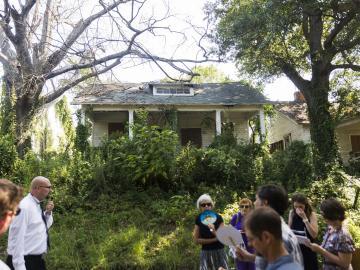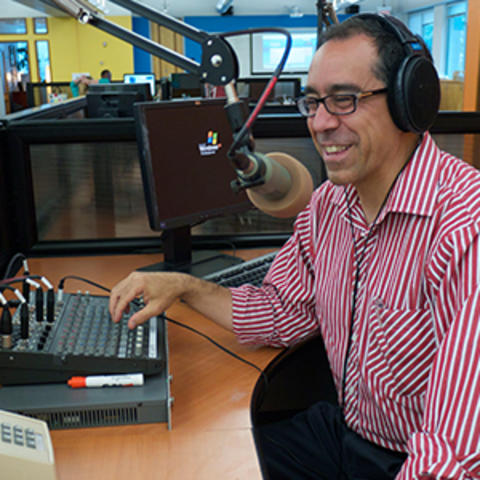Section Branding
Header Content
Tearing Down Blight In Macon-Bibb County
Primary Content
In February Macon-Bibb county commissioners agreed to take $4.5 million and spend it on 15 blighted projects in the county. One commissioner called the move historic.
Building an arts village in Mill Hill, tearing down blighted homes in Village Green and Tindall Heights, all of these projects were part of the initial outlay of blight money by Macon-Bibb County. There's still a little less than half of the $10 million borrowed for blight projects.
So, where do things stand today with battling blight? Cass Hatcher, hired by Macon-Bibb as a blight consultant, addressed that issue.
Discussion with blight consultant in Macon-Bibb, Cass Hatcher.
Cass Hatcher: Right now where we stand is the acquisition of properties. As you know we just can go down and tear people properties down that still have property rights. So the Land Bank Authority is right now in the process of acquiring some 227 properties. So once we acquire those properties, we have site control. Then I can go in to do the testing, abatement and demolition and remove those properties and put them in the hands of an end user.
Michael Caputo: Well that's not an easy thing to do I mean razing these dilapidated buildings first means you have to have them. Talk about that process of acquiring homes.
Cass Hatcher: Well the process was first, actually, we have to put a process together. When I met with the with the county we had to identify projects we had look at critical mass and to look at where was all the projects adjacent to where the blight was. So we can piggyback on those and use synergy. So once I created a process, the commission identified the projects. I went ahead and evaluate each project, determine whether was in an urban redevelopment plan. Was it blighted... did it meet the blight definition and then made a recommendation to the commission that these are the properties we need to go after. The Land Bank Authority then goes after them using a couple tools in their tool boxes. In rem foreclosure, in terms of delinquent taxes... are.
Michael Caputo: In rem foreclosure is a court proceeding.
Cass Hatcher: It's a court proceeding exactly. And so that's what we're in the process now. Many of the properties right now, that 227, are going through the in rem foreclosure process and those that are not delinquent taxes that do not have delinquent taxes, the Land Bank is negotiating with the owner to see if they can acquire it, get a clear title. Once they can have a site control. Then that's when the work really begins.
Michael Caputo: How are we going to see progress? What's the best way for us to see a change going on here right now?
Cass Hatcher: Well once you start seeing equipment, heavy equipment moving on to the sites... a lot of dust in the air... of course they're coming down and a lot of buildings coming down. And then people coming back and putting something back into those properties. That's when you're going to kind of see things happening. Right now the in rem foreclosure process is a long process. Because its the court proceeding, as you indicated, it takes anywhere from six to eight months to actually get the properties in our hands. And the Land Bank is working very, very hard to make that happen. And we hope to start seeing some things around July-August where we can really go out and start tearing down properties and moving forward.
Michael Caputo: How important is it for there to be a plan in place to rebuild on places where you're tearing down.
Cass Hatcher: That's very important. One of things that we did not want to do is just basically leave an empty lot. And so we identify end users for almost all the projects. When someone want to come in and do a park. Want to come in and rehab some of the homes. One of things that we're working with now, which is a neat project, is working with the Parks and Recreation, where we found dilapidated properties around a park that we can be able to expand that park and have it have it used by more of the community and so we're doing a couple of parks that way where we're tearing down properties that are right adjacent to a park.
Michael Caputo: Oh is that right? So where is one of those places.
Cass Hatcher: Maddie Hubbard is one of the parks that we're looking at over in Pleasant Hill. And so there is a bunch of dilapidated structures along Pursley Street that is right adjacent to the park and so we met with the planner of Parks and Rec. They put together a master plan, we met with some of the community leaders and then we're going to be briefing them probably in about two to three weeks on what that park will look like once those house are gone.
Michael Caputo: One more question, is $10 million a good amount? Is that enough to deal with what we've got going on here?
Cass Hatcher: Ten million is just a drop in a bucket. You know hopefully this process that we put in place will allow us to go after other funding, either through some other means to continue this process. Say two hundred twenty seven properties, We're probably in the next round to get around hundred and fifty. You still got thousands of properties out there that need to be torn down to be removed.
Support for Health, Education, and Poverty reporting on GPB Macon comes from the Peyton Anderson Foundation.


